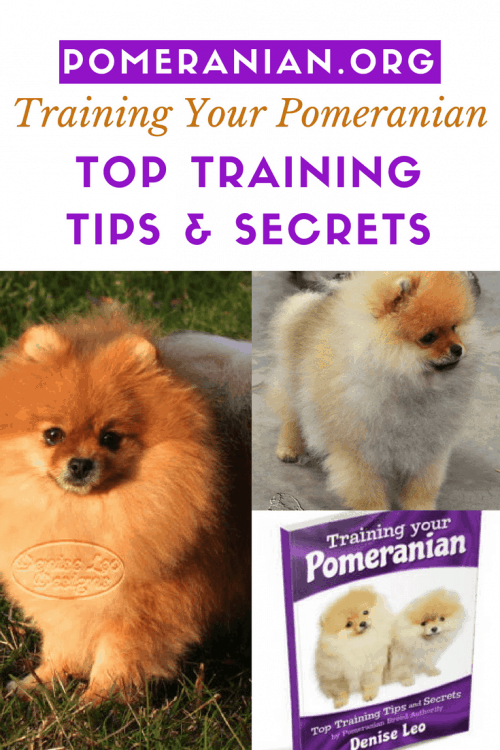Last Updated on 24/04/2024 by Dochlaggie. Post first published on October 8, 2021.
This Pomeranian training guide contains essential Pomeranian adult and Pomeranian puppy training techniques. These training Pomeranians tips are both remarkably effective and fun for both owner and dog.
Training a Pomeranian is the must have book for all Pomeranian parents.
Pomeranian Dog Training Tips Include:
- How to train a Pomeranian puppy. Starting your new puppy off on the right paw.
- Basic Pomeranian training for owners and puppies.
- How to toilet train a Pomeranian puppy and older Pomeranians.
- Pomeranian potty training Housebreaking fundamentals.
- Pomeranian puppy training techniques.
- Crate training a Pomeranian puppy.
- How to communicate with your Pomeranian.
- Using verbal commands correctly.
- How to understand your Pomeranian’s body language.
- Learn how to teach the commands “COME” “STAY” and “SIT”.
- Teach your Pomeranian training tricks
- How to handle behavioral problems, aggressive behavior.
- Pomeranian Separation anxiety.
- Hyperactive Pomeranians.
- Training a Pomeranian not to bark.
- How to deal with nipping or biting, chewing, jumping on people.
- Territorial aggression.
- Teach your Pomeranian to enjoy grooming.
- Training a show Pomeranian puppy, baiting, gaiting and table training.
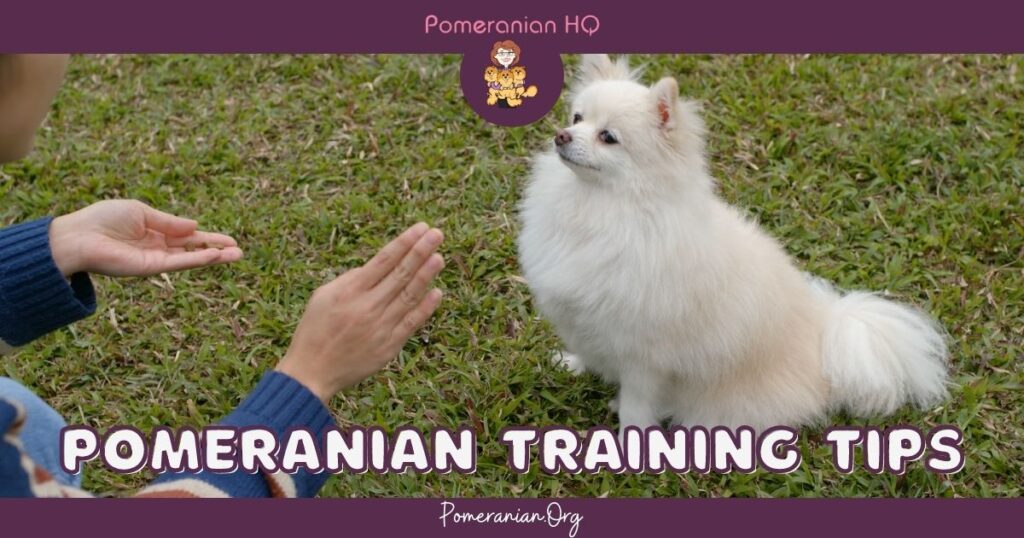
How to Train a Pomeranian Puppy
Prior to starting training a Pomeranian dog– If a Pomeranian doesn’t fully understand the basics, then it’s essential for him to go through basic Pomeranian obedience training.
It’s never too early to start Pomeranian obedience training, so that cute Pomeranian puppy you bring home at eight weeks of age is able to learn and even the 15 year old senior dog still has the learning capacity.
There Are Plenty of Benefits to Basic Pomeranian Obedience Training
Life will be easier because you can communicate your needs to your dog and vice versa.
It’s good if you need to prevent your naughty Pom from getting away with a sneaky something because your command will interrupt what he’s up to. The Pomeranian training sessions are ideal for bonding with your Pom because it’s teamwork. All dogs feel a surge of self-confidence when they master new commands.
Are Pomeranians Easy to Train?
Dogs are as smart as a 2-3 year old human child so it’s essential that you let your Pomeranian dog think and perform as he gains increased self-esteem and becomes a happier dog because he’ll feel more comfortable in his new home.
Pomeranian training tricks and elements of basic Pomeranian obedience training are very simple to understand for both you and your canine companion. There may be a tiny variance from one trainer to the next but, overall, these commands have been the same for many decades. The big difference is how YOU prepare for Pomeranian dog training.
Preparations for Becoming a Terrific Pomeranian Trainer
In your trainer role, your focus is to guide your Pomeranian in an encouraging, steady manner. He won’t obey you if it’s no fun. You have to gently guide your new Pom through an action plan that reaps rewards along the way. It’s impossible to teach your Pom any new command in only in 1-2 days so you must be patient.
It’s a process that improves as your Pom participates, and he’ll learn the basics bit by bit. By the end of each Pomeranian training session, you should notice a little more improvement and this means that, eventually, your puppy will be completely trained.
How to Use a “Pomeranian Dog Trainer Voice”
Regardless of how comfortable you feel about Pomeranian dog training, talk as though you know exactly what you’re doing and what you expect from your Pom. Use a firm, friendly tone and articulate everything you say as clearly as you can. When praising your dog, make sure your voice is exceptionally happy.
How Important is Timing in Pomeranian Dog Training?
Timing plays a massive part of Pomeranian dog training. Your Pomeranian needs to learn that what he does is either right or wrong BUT this is where the timing is so critical.
Never reward your Pom more than 5-10 seconds after his action. If you can’t immediately retrieve a treat from one of your pockets or bags, you’ll be unable to mark the thing he did right and he may get confused about what he did that was good.
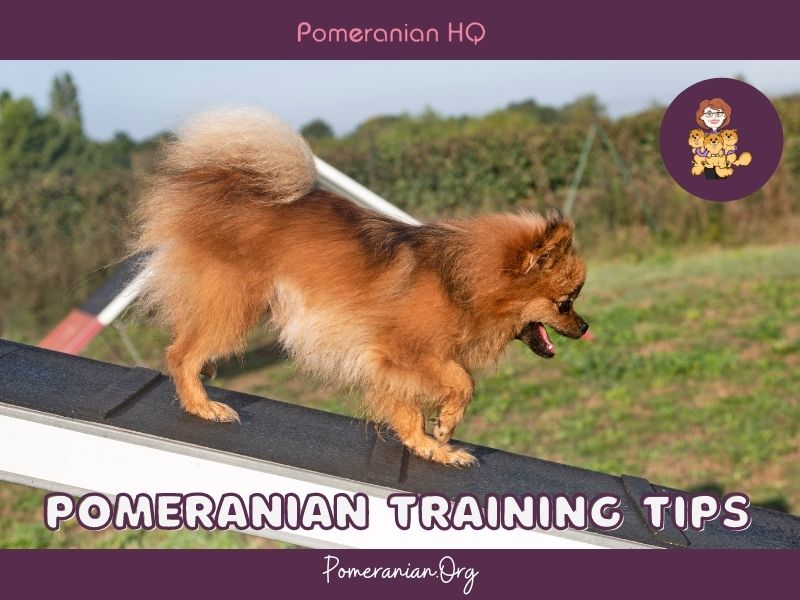
Choose Rewards for Pomeranian Dog Training
Pomeranian dogs are always keen to please you BUT when it comes time for Pomeranian obedience training, you need to offer additional motivation. Find special treats you only use for training so he’ll soon learn that he has done well. If you use a piece of kibble, for example, he won’t really fuss as he eats that each day.
Special treats can include: crispy microwaved bacon (after placing pieces on paper to drain the excess grease), tiny meatballs, uncured organic hotdogs and other foods will leave your Pom salivating in anticipation.
Treats will only work in the short term. You don’t always have to provide a treat if your commands are obeyed. Your voice will trigger an automatic reaction when commanded. You may have to repeat each command 100-500 times before your dog understands what he must do when hearing or seeing that command.
Ensure Your Pom Remains Feeling Healthy and Happy
Don’t allow your Pom to make a mistake more than twice or three times in a row. If he’s admonished and feels like a failure, his motivation will decrease. If he’s not succeeding, you can return to an easier step of this process and then he’ll settle back into his pattern of behavior.
Patience is a Virtue in Training a Pomeranian Dog
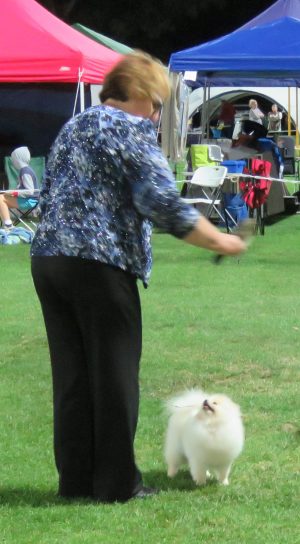
Never start a Pomeranian training session if you don’t feel patient. Perhaps you have had an incredibly bad, stressed day at work. If so, your dog will sense the bad vibe. It’s not good to miss too many consecutive days of Pomeranian training, but the occasional day is better for you and your Pomeranian dog.
Finish Pomeranian Obedience Training in a Positive Way
This applies to everything including playing with your dog, walking him, and training him. Every Pomeranian training session needs to end in a positive way so he’ll be ready the next day when it’s time to train or play. He won’t feel physically and mentally exhausted.
The Precise Words to Use in Pomeranian Dog Training
Use short specific words because they’re short and consistent. Dogs only focus on the first syllable of any word
“Whoops!” This is used when your Pom does something wrong. Don’t say “no” because it’s a word best avoided unless there’s an emergency. Use “whoops” in a light-hearted manner.
“Okay” is what you use to allow your dog to move from his statue-like position.
E.g. If he’s told to sit, he won’t know for how long to sit there. When you’re ready, release him from a seated position or make him get down.
“Good, sit!” “Good, come!” and other command words are better than using “Good boy,” or “good + his name.) Say “good” and follow it with the command you wish to use as this reinforces everything you have taught him thus far.
Pomeranian Training Time
If you have multiple Pomeranian training periods each day, your dog can learn a command in roughly 2-3 weeks. However, you need to regularly use the commands or your Pom may forget them, even once training is complete. You don’t have to provide treats all the time so when you do use them, your dog will appreciate them even more as he knows he’s being good.
10 Pomeranian Training Tips To Remember
- Reward your Pomeranian with special treats, not ones he gets on a normal day.
- The reward must be given at the exact moment your Pom has obeyed your command or is in the right position.
- Don’t forage around in pockets to find treats. They should be in your palm, able to give to him instantly.
- The ideal training time is when your dog feels hungry. It should be a good time for you every day so he gets into a routine and this makes him easier to train.
- Obey the rule” training time before playing time.
- Always finish your training sessions while your Pom wants to keep going. Then he’ll be keen to start the following day.
- Be consistent.
- Motivate your Pomeranian.
- Be incredibly patient. If you’re lucky because your Pom does what is commanded on the first day, it isn’t because he has mastered that specific command. It’s just luck.
- Have fun and plenty of it!!!
How to Train a Pomeranian Puppy to Sit
This is usually the very first command that you should teach in Pomeranian puppy training.
How Long Does it Take to Train a Pomeranian Puppy to Sit?
It will take 2-4 weeks to achieve this simple goal. Your aim is to ensure your Pom will remain in a sitting position on his hindquarters until you allow him to move.
- Either kneel or stand directly in front of your Pom. Have a treat in your hand and hold it a little bit higher than his head.
- Move that treat slowly back until it’s directly above your Pom’s head. This will make him point his nose upwards and his butt will drop. If it doesn’t drop, slowly keep moving that yummy treat backwards towards his tail. The second his butt is on the ground, drop the treat and tell him “Good sit!” in a pleased voice.
- If your Pomeranian doesn’t react to this temptation, put your thumb and index finger either side of his haunches in front of the hip bones. Apply a little pressure and rock his body into a sitting position. Then reward and praise him while he sits.
- After he has been consistently sitting when told, wait a few moments prior to giving him a treat and only ever do so if he’s in the right sitting position.
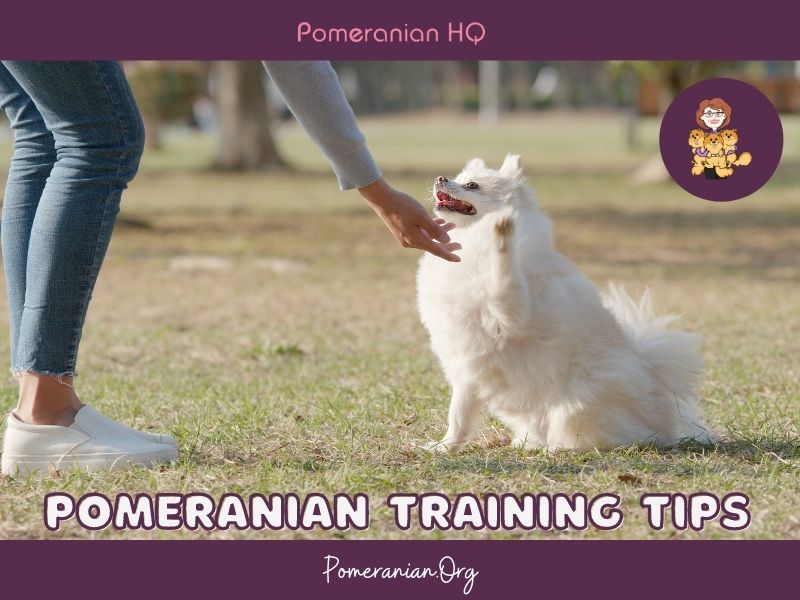
Pomeranian Training Troubleshooting
If your Pom is cheeky and jumps up to try and snatch that treat, lower your arm so he can get at it while he’s standing. If, however, he sits for only a second and then gets up again, firmly and gently nudge him back to his sitting stance. After he has learned the right way to behave, he must not move until you release him. Never give him that treat unless he has sat for at least a count of three.
Teach your Pom to sit prior to being given his meal. This strengthens your role as the leader of the pack.
The Down Command
Some dogs are smart enough to learn this as fast as the sitting command while others need more time. The end goal is that he needs to be resting on his belly and chest, or askew on a hip.
- Start with your Pom in a sitting stance and facing you. Have a treat in your hand and first hold it on his nose and then slowly lower it to floor level.
- With some luck, he’ll follow your hand with his nose and lie down. If so, give him the treat as you praise him and say “Good Down!” It’s critical that you only ever give him a treat once he has done as commanded and is in the right position (in this case it’s laying down). Don’t allow him to have it if he stands up because it’s too late. In his mind, the reward is for standing up. If he hunches over and doesn’t actually lie down, slide it towards him or away from him while it’s on the floor. Be patient and encourage him. If he remains focused, he should end up in the right position.
- If he’s stubborn and the treat isn’t motivating him, apply gentle pressure between his shoulders and push down and to his side. The instant that he drops down, praise him and allow him to have the treat. Although your Pom should obey vocal commands and not need physical pressure, adding this additional step can teach him what you expect from him particularly in the early training stage
- Once your pet has finally mastered lying down whenever he’s told, start delaying the time when you allow him his treat. While he’s in the laying down position, say “wait…wait” and, when ready, “Good Down!” (using your happy voice) as you give him that yummy treat. By delaying this period, he’ll learn to pay closer attention and, ideally, won‘t move until you have praised and released him with the “Good Down” command.
Down Command Troubleshooting
If your Pomeranian doesn’t remain down, don’t give him a treat. Instead, command him to lay “Down!” If he’s unable to get past this particular command and won’t remain on the floor, put his leash and harness on and use your foot to keep the leash on the floor so he’s forced to stay down until released. Use the word “Okay” for this. Don’t be so close that his body moves; your foot will be enough to ensure he stays down. Make sure you have a decent harness so it doesn’t injure your Pom.
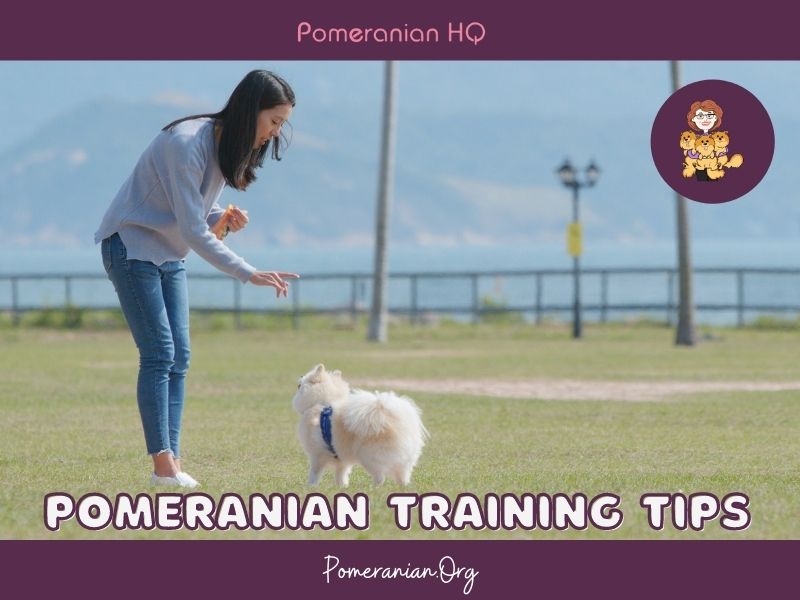
Training a Pomeranian to Stay
How Long Does it Take to Train a Pomeranian Puppy to Stay? Training a Pomeranian to stay can take 3 to 6 weeks. This is because his natural instinct is to come running to you whenever he sees you. You want to train him to stay in whatever position he’s in (provided he can hear you), until you release him.
- Begin with your dog in a lying down or sitting position because it’s less likely he’ll move from those stances. Use a harness and leash for total control. Stand in front of him, holding your palm out flat towards him (almost touching his nose) and, using a serious tone, tell him to “stay!”
- Next, move a couple of feet away from him, maintaining eye contact, and then come back to him. Praise him and say “Good. Stay!” Then give him a treat. Remember that he must still be in the staying position when you do so.
- If your naughty Pom moved from his position prior to being released, firmly place him back where he should have stayed.
- As he gets better at obeying, increase the amount of time he must stay and also the distance you can get from him and still have him obey you. If he falters, simply go back a step and then try again.
Training a Pomeranian to Stay Troubleshooting:
If your Pom keeps breaking his ‘Stay’ before you say “Okay”, do not show him the treat until you give it to him, be what is causing him to move. Vary what you do; sometimes return to him and leave him without rewarding.
Teaching Your Pomeranian to “Come”
There are two distinct types of dog owners. One has no need of this command because their dog will come running all the time. The other owner is in desperate need of it because it’s simpler to get a toddler to obey. Your goal is that your dog should come to you, irrespective of what he’s doing at the time.
This command should end up with your dog sitting next to you. This is very much a “hands-on” command as you need to physically make your dog obey (without any harm to him, of course), to teach him to understand what to do.
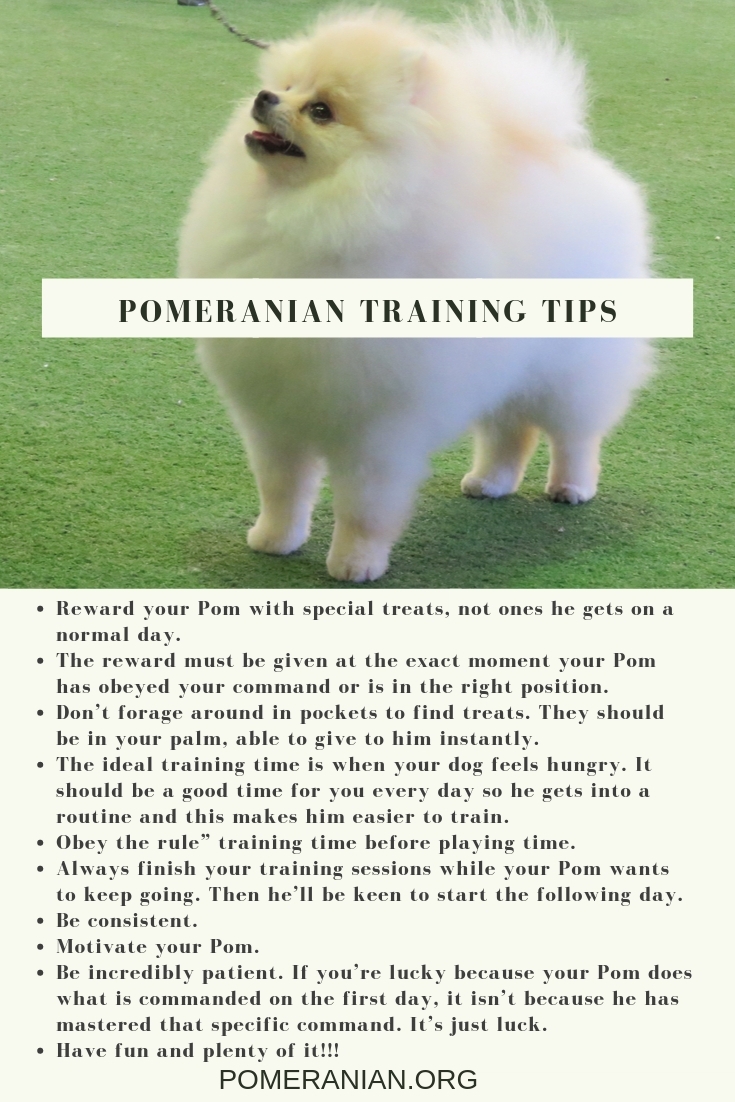
Dogs often resist and it may take a long time and numerous Pomeranian dog training sessions before success is achieved. It’s a command that will be used for your dog’s whole life so if he doesn’t do as he’s told, you’ll need more sessions. Never use it if your dog really hates something. On those occasions, it’s best to walk to him and pick him up.
You can reward your dog with a treat and praise if he obeys. However, if he doesn’t obey, you can’t just say “whoops!” You must carry or use a leash and harness to move your dog to the spot where you were standing when you told him to “come.”
When doing this training, your dog should have a harness and leash but NOT a collar or he could get harmed, especially if you tried to pull him to you and he struggled and the collar hurt or damaged his neck. If you don’t already have it, get a harness prior to carrying out this training.
- Attach a 6 foot lease and harness to your Pom and then firmly tell him to “Come!” Say this only once. As you do so, gently pull him to you quickly and then give him a treat as you praise him and say “Good. Come.”
- Repeat this training as often as necessary but never do it without the leash, even when he comes to you willingly.
- As your dog gets better at obeying you, get a longer leash or one that retracts so you can add more distance each time you train.
- Once you’re ready to try it without a leash, make sure it’s done in a fenced-in space that’s safe. Keep his leash attached but you don’t have to hold it. If he doesn’t come to you when called, walk to him, take the leash end and firmly guide him to where you were when you issued the command. Don’t provide a treat if he obeys the first time you say it. Put the leash back on and do it five successful turns prior to allowing him to do it with the leash NOT in your hand.
Teaching Your Pomeranian to “Come” Troubleshooting
If your Pom runs off as soon as the leash is let go, don’t go after him. Stand still and repeat the “Come” command. If necessary, return to the on-leash training.
Pomeranian Trick Training
Shaking a Paw (One or Both)
Everybody loves this Pomeranian dog training trick, whether family, friends or strangers. Your Pom will feel great because he’ll get a LOT of attention just by shaking your hand. The aim is for him to lift his paw to the height of his chest so you can shake his paw. He should be able to do it with either paw.
The command is “Shake” and that’s when he’ll lift his right paw.
The command for the left one is “Paw.”
However, let’s train with the right one to make it easier to follow.
- Have your Pom seated in front of you and a treat is hidden in your left hand which is near to the ground.
- Persuade him to paw at your hand by saying “Get it” and “Shake.” The moment he lifts his paw, say “Good. Shake.”
- Rinse and repeat as often as it takes for him to consistently lift his paw to his chest height.
- Change to hand signals if you like. Make a fist with your hand and your index and middle fingers should be straight out.
- Stand with the treat behind your back, treat within it, and put out your right hand and use the visual “Shake” command.” When your beloved pet paws your hand, support it while giving him the hidden treat from your other hand.
- Repeat these actions using your opposite hand and the “Paw” command. When he does as he’s told, say Good Paw!”
Pomeranian Trick Training Troubleshooting
If your Pomeranian dog nudges your hand when he should be pawing it, pull your hand in fast and begin again. If he refuses to even move his paw, softly lift it so he can learn what you expect. As he gets better at it, he’ll do it with no help from you.
Pomeranian Leash Training
Training a puppy to walk on a leash is very important, especially in suburban and urban areas where traffic can be a problem. Many small dogs, including Pomeranians, don’t work well with a collar and leash. It’s often best to use a harness and leash to keep from injuring their neck or shoulders. It should be a slow process reinforced with treats, just as all of the other training has been.

I’m passionate about training puppies by using a leash. In some ways it resembles the way a human baby works out something new or sees something they haven’t seen before. Think of a ball of clay, waiting for your hands to mould it into something special. Remember that new puppies haven’t experienced wearing a leash until now. Most breeders don’t have time to ensure all puppies are properly crate and leash trained.
This is good news because it means you can train your new puppy to do what YOU want and have loads of fun doing so. It’s critical to get your puppy used to a leash in a positive manner, especially if he hasn’t had any leash experience.
Start by putting it on him and just let him move around like normal, so he gets used to its feel on his own. Never pull or yank it or you may frighten your new pet. Once you can see he’s used to the leash, you can begin to train him more. Gently pick up on the leash so he feels a little resistance as he tries to move. As you increase the tension, reward him with treats and positive praise for doing so well.
If you train your new pet, he shouldn’t have any bad habits that need breaking. Training any new puppy means making sure he enjoys whatever you’re doing. The use of positive reinforcement will help avoid poor behaviour such as: barking, lunging and pulling, while being attached to a leash.
Tips on Successful Puppy Pomeranian Leash Training
It’s essential to teach your puppy to do everything you want from a very young age. Train him to think it’s what HE wants and then he’ll learn how to manipulate you to ensure he gets everything he wants.
The irony is that he only thinks he’s manipulating you but YOU’RE really the one choosing what to ignore and what aspects of his behaviour needs to be changed so you’re both happy in the end. Nobody likes working for free. You may offer volunteer services to others in your community, not for money, but for that “feel good” sensation.
It could also be to grow your network or to meet other people. Learn what gives your new puppy the motivation to behave in the way you want.
Other puppy motivators include: treats, toys, affection, praise and play time with you. Use all these ideas to make him enjoy being trained.
Regardless of whether you’re a dog or a person, everyone loves receiving praise and compliments; delicious treats and playful fun.
Pomeranian Leash Training Should Be Fun for Owner and Dog
Dogs love playing games and having fun. It’s great if you can play different games that you mutually enjoy because you’ll also strengthen your bond. Your puppy is more likely to obey training instructions if he can also have some play time.
When you’re conducting leash manners training, good motivators will help a lot. If he’s doing what you want, you can keep eye contact and smile, enjoying what you’re doing. If he’s misbehaving, don’t look at him. This way he’ll learn to always watch what you’re doing and it reinforces the right manners.
Always praise him if he’s looking you in the eye whilst on his leash. If he’s doing that, he has to be close to you and not looking anywhere else.
Pomeranian Puppy Training Techniques:
- Start his training early to solidify good habits and crush bad ones.
- Work out what motivates him the most.
- Offer praise when he behaves properly.
- Strongly encourage puppy to maintain eye contact.
- Make leash training a game that’s fun because then you’ll find it easier to accomplish. It’s crucial that your puppy is leash trained. Ensure it’s fun for both you and your new puppy because he’ll learn faster that way. Use doggy psychology to get what you want. Remember that the good work you put in today will form the base for a lifetime of pleasure and good behaviour.
Best Way to Train a Puppy to SIT
How to train a puppy to sit. The best way to train a puppy to sit is also within the realm of training by an owner, usually without the help of a professional trainer. There will be more steps involved, but a solid foundation with the use of the commands COME, NO and STOP will help you to achieve success with patience and practice.
Treats, praise and extra attention are all acceptable rewards for proper behaviour. Many dogs will sit naturally when a person walks up to them but, as a preferred behaviour to having a dog jump or run around at a person’s feet, the action of sitting must be associated with the word SIT.
The owner should always have a pocket full of treats before starting any training session. Allow the Pomeranian to see the owner with a treat in his hand. Hold the treat above the Pomeranian’s head but not too high or they may jump for it. (This is an entirely different behaviour that the owner will want to associate with the command JUMP.)
While holding a treat and calming the pet so he’ll listen, say his name and the word SIT. While saying the pet’s name and the word SIT, slowly move the treat above and behind the pet’s head.
Teaching your Pomeranian Training Tricks

Fetch
It is extremely easy to get your Pomeranian to chase after something you throw. The genuinely tough thing is teaching your puppy to carry the item back and give it to you.
To teach puppy to bring items back to you, start by throwing a small toy. When puppy has the toy in his mouth, call him back and show him a treat.
Give puppy lots of praise if he moves in your direction but only give him the treat when he comes to you. If puppy drops the toy, start the game once again.
Stay and Fetch
This particular trick can only be taught once your Pomeranian has mastered the commands STAY and FETCH . With the Pomeranian responding to your STAY command, throw a small toy.
Continue praising your Pomeranian whilst he holds the STAY command. Wait a couple of seconds before saying GO and then your Pomeranian will run and retrieve the toy.
Teaching Your Pomeranian to Speak
As soon as your Pomeranian starts barking, say SPEAK and give him a treat. After a while, he’ll start barking as soon as you say SPEAK.
Teaching Your Pomeranian to Sing
Howl just like a dog until your Pomeranian begins to howl with you. Reward him with a treat and say SING. Keep practicing until your Pomeranian understands to sing on command without you singing along.
Teaching your Pomeranian who is Leader of the Pack
In order for any form of training to work, your Pomeranian MUST see you as the leader of the pack. This training includes housebreaking, heeling and commands, as well as behavioral training such as barking, jumping, begging and so on.
Every dog (including cute Pomeranians) lives by a natural instinct. He lives in his house/den and everyone (human and canine) are part of his pack. Every pack must have a leader. That’s the way that canines live and there aren’t any exceptions to this “rule.”
You may simply assume the leader is yourself. However, in a lot of situations, your dog won’t have any idea that you believe this is the case. You MUST make your position clear because if you don’t. your dog will find it hard to identify the leader and, if there’s not an obvious one, he’ll take the role for himself, believing he’s the natural leader.
It’s not hard to teach your dog that you’re his leader. The difficulty is that lots of owners don’t carry out this training on a consistent basis. You, and all the other household members, must obey the rules each day. If you don’t do so, a dog may falsely think that you, as his leader, is becoming weak.
In the dog world, a leader can’t be perceived as weak, and it’s possible another stronger dog will try to take over the role.
These steps aren’t hard to do. Consistency is the key and they need to be obeyed all the time.
- Make it crystal clear that you’re the provider of the food. If your pet Pom goes to his bowl and it’s full of food, he won’t associate you with filling it. He must also obey the “sit” command before his food is given to him.
- The leader must eat first. It’s common for there to be a minimum of one meal a day when you all start eating at the same time. Make it very clear that you’re the leader and, as such, you’re entitled to start eating first. You’ll fill his bowl but will leave it on the bench out of his reach.Prepare your own food and set it on the table. Then sit down and take a few bites, while your Pom watches you. He may whine, bark, circle or jump but ignore him because he’ll stop quickly. When he stops and is silent, stand up and pick up his bowl, command him to “sit,” and then put his meal down on the floor so he can eat.
- The pack leader must always exit and enter the den first. Each time you both go out or come in, you must be first. This will take some practice. You’ll learn how to stretch your arm out to make him stay inside or outside the door.
- Certain things have to be earned. You won’t need to do this all the time, but when you give your Pom a treat or a new toy, he must obey you and “sit” when ordered, before receiving what you have for him.
Please note: whenever your Pom is acting up or not listening to you, a major component of this is an incorrect interpretation of hierarchy. You must ensure you and all other people in the den follow all these steps AT ALL TIMES!
Dogs feel much more content and relaxed once they understand who their leader is. When this isn’t clear, they can feel confused, stressed, and uneasy.
Final Thoughts on Pomeranian Training Tips
Pomeranians are extremely intelligent and eager to please their owners. Pomeranian dog training is best done in short sessions with plenty of praise and treats. Don’t forget to purchase the Pomeranian training guide.
It can be difficult to train a Pomeranian, but if you follow the tips we have laid out in this article and put some time into training your pet, it will soon become an obedient companion. Remember that patience is vital when working with any animal (or person!).
If you need more help or have questions about anything we discussed here, please don’t hesitate to contact us directly for assistance. I am happy to answer any questions and provide personalized guidance on how best to take care of your furry friend! What do you think? Will these pomeranian training tips work for you too?
Copyright Pomeranian.Org. All Rights Reserved.
References and Further Reading:
[1] Denise Leo “The Pomeranian Handbook”.
[2] Denise Leo “Training Your Pomeranian ”.
Pomeranian Training Guide
Written by Pomeranian Breed Authority Denise Leo of Dochlaggie fame.



